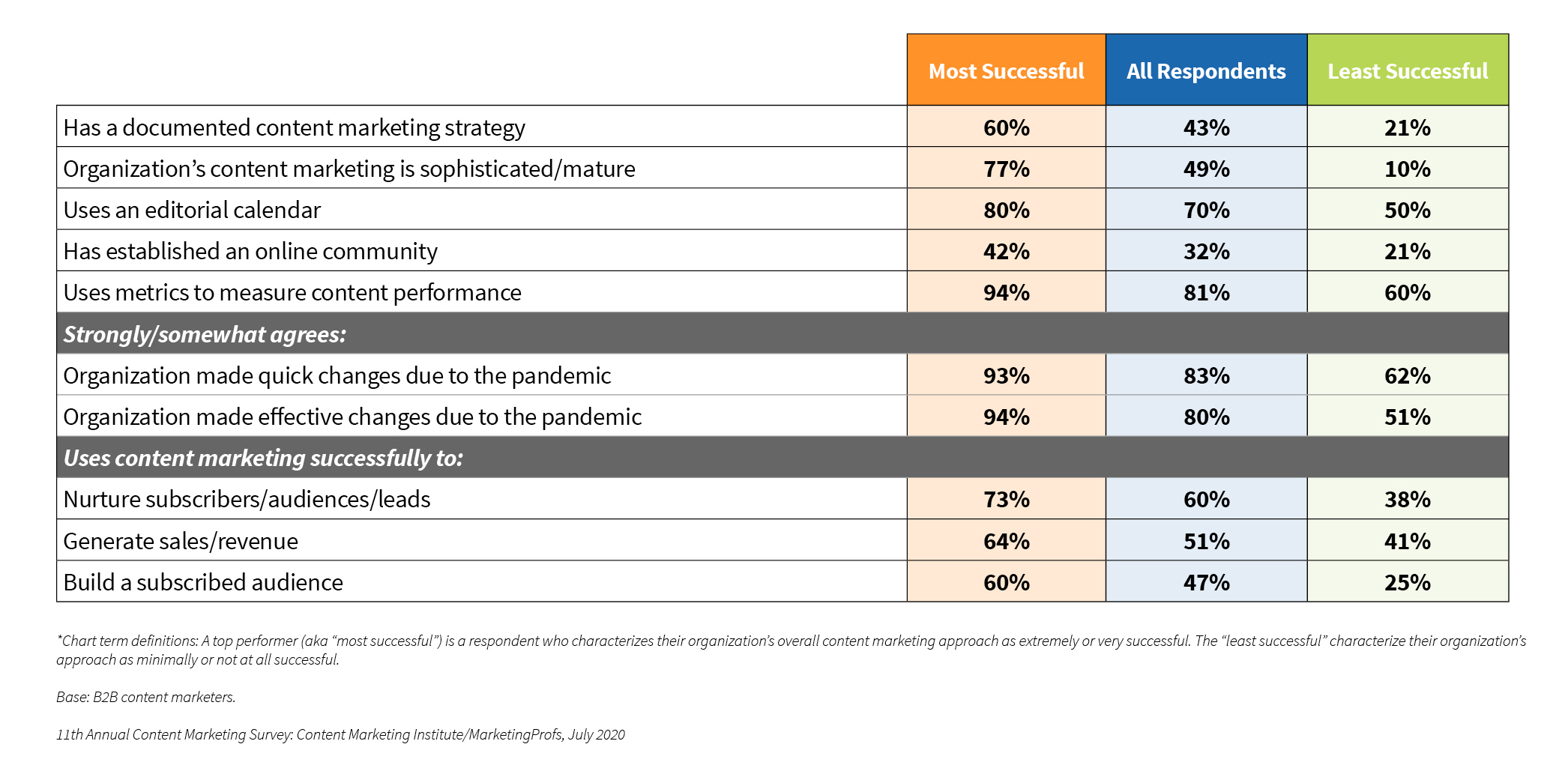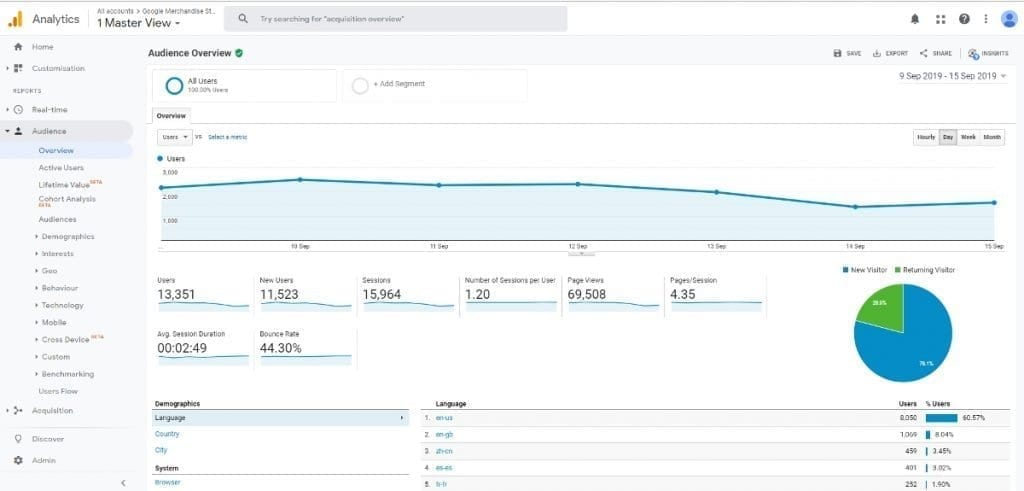
Content marketing has the potential to do great things for your brand. However, like any marketing initiative, you need to understand how it’s impacting your organization and the ROI (return on investment) it’s delivering. Quantifying content marketing is a standard part of determining its performance.
Your efforts, campaigns, and strategies are all trackable and measurable. The key is to focus on the metrics that matter. Those metrics should deliver actionable insights that improve attracting, converting, and retaining your audience. So, how are you quantifying content marketing? And is it working?
Quick Takeaways
- Quantifying content marketing requires a framework of what metrics you’ll measure, how you’ll measure them, and what you’ll do with findings.
- How and what you measure should align with the goals in your content strategy.
- The key to learning from quantifying is taking action based on insights derived.
What Should You Expect from Content Marketing?
Before you quantify, you should understand more about content marketing ROI. Content marketing costs 62 percent less than traditional marketing and generates three times more leads.
This average could be a baseline or your goal, but it gives you some context around ROI. How you get to ROI is different for every company. It depends on what your goals are and how you measure. You will struggle to understand and prove ROI without measuring and quantifying your initiatives.
Are Organizations Measuring Performance?
Without a way to measure performance, you’ll never understand its impact or be able to improve it. So, the first question is, do you measure it? According to the CMI (Content Marketing Institute) 11th Annual B2B Content Marketing report, most content marketers are at 81 percent.

What do they measure is the next question? According to the CMI report, the most popular metrics are website traffic, email engagement, website engagement, and conversions.
All the metrics in this chart are trackable with the proper framework and commitment to measuring performance. However, you shouldn’t measure something just because. Instead, it should reflect the goals you are attempting to reach.
For example, if your goal is to nurture leads to become customers, you’ll be looking at specific metrics that contribute to this, like email engagement, since it’s the best nurturing channel. Additionally, you’ll be looking at that prospect’s customer journey. What content are they consuming? Is that causing them to then move to the next step or convert?
These are the kinds of questions you want to be able to answer when quantifying content marketing.
Quantifying Content Marketing: What, When, How, and Why
Now that we’ve gone over the basics, it’s time to look at quantification at scale.
What Will Your Measure?
The first step is to build a framework. One of the most critical parts of this is your content strategy. If you don’t have one, then that’s a necessity before you can measure. Why? Because a content strategy is your playbook. It defines your objectives and what success should look like by determining KPIs (key performance indicators).
So, what metrics matter to you based on your goals? There are so many possible options here, but in concentrating on what metrics provide a clear picture around performance, you should focus on:
Consumption Metrics
These measurements detail how and what your audience is consuming. They can offer great insights into the most popular types and topics. The essential consumption metrics include unique visitors, pageviews (total and unique), time on page, bounce rate, and frequency.
Engagement Metrics
Next are metrics that add context to consumption. You’re learning what and how users view your content, but is it relevant and interesting? You can make some general assumptions based on time on page and pageview, but to go deeper, the Audience Overview in Google Analytics digs deeper.

The other part of engagement is what’s happening on social media. Engagement means different things on each platform but typically includes shares, comments, and referral traffic.
Rank Metrics
Likely one of your content marketing goals is to improve organic rank. You’ll measure this by tracking the SERP ranking of all the keywords you’re targeting. Do this monthly, as ranking fluctuates. The best way to manage this without it being a time drain is using a tool like SEMrush or Ahrefs.
Lead Generation Metrics
Content marketing’s foremost objective is to attract your ideal buyers. Your content is the hook to gain the lead. Much of the time, you’ll be doing this with gated content—eBooks, whitepapers, case studies, etc.
Other avenues include users that click on a lead form from a piece of content, which is trackable with the right Google Analytics Campaign URL builder. Additionally, you can look at referral traffic to the forms and track visitors with cookies.
Conversion Metrics
The next category is how you attribute specific sales, which mirrors some of the lead generation areas. However, you’re looking at specific revenue generation from content marketing efforts. Google Analytics will be key here, as will campaign URLs.
The conversion or win could be an actual purchase of a product via eCommerce, registering for your service or software, or any other conversion that equates to acquiring a new customer.
How Often Should You Measure?
Once you have defined your metrics, you should consider how often you’ll measure. You’ll want to look at most of these monthly. However, you might not have much data after only one month, but that’s your baseline.
For example, when tracking organic ranking, you’ll know where you are on Google results in the first month. However, you don’t yet have a comparison. The following month, you’ll have movement up or down and calculate your percentages.
Wrangling Data
Another aspect of quantification is accessing and aggregating data. It lives in many places – Google Analytics, social media sites, SEO tools, and more. Ideally, you’ll want to employ a content marketing platform that combines data from multiple sources and provides clear reports.
Measuring content marketing performance shouldn’t be a manual, time-consuming process. If it is, you’re likely to get lax about it and lose focus. Use technology to streamline this, so it’s always easily viewable and transparent.
Data to Actionable Insights
Now that you have your metrics, what’s next? The data on your content marketing efforts should inform what you do next. With analysis, you should be able to identify themes or “aha moments.” It should also tell you what your audience likes and doesn’t. Here are some examples.
- Your data tells you the topics and formats of content users like best based on consumption, engagement, and SEO metrics. Take that and ideate on new content pieces that match what your audience wants.
- Based on the lead generation metrics, you’ll learn what channels are most effective in attracting leads. This could be paid or organic. From this intelligence, you can create new campaigns that follow this pattern.
- From your ranking metrics, when you see a post falling off, try to determine why. Does the content need a refresh because it’s out of date? Did a competitor publish a piece that has more meat? When you know why you can update the content to boost its credibility. You can then redistribute it.
Quantifying Content Marketing Starts with Consistently Creating It
For content marketing to deliver ROI and be meaningful, you need to be consistent in publishing and distributing it. That can be a challenge for many organizations, but we can help.
If you are ready to get more traffic to your site with quality content published consistently, check out our Content Builder Service.
Set up a quick consultation, and I’ll send you a free PDF version of my books. Get started today and generate more traffic and leads for your business.
The post How Are You Quantifying Content Marketing Initiatives? appeared first on Marketing Insider Group.
0 Commentaires